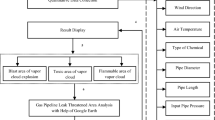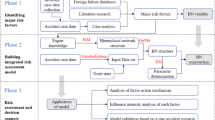Abstract
The power plants of each country can be considered as one of the most important factors in economic development and growth of that country. Accidents at power plants are very dangerous and make their accessibility difficult. So, it is critical to be able to predict and appropriately assess the relevant risks. In this study, we focus on hydrogen gas leakage from chlorination unit as the study scenario to evaluate potential risk of accidents. We then use the Bow-tie technique and Bayesian Network analysis to determine the type and the relationship between the effective causes of the catastrophic accidents. According to Bayesian Network, decrease in flow rate in the ventilation system of the storage tank was identified as the most probable base event, and erupted fire/sudden fire/explosion were identified as the most probable consequences of occurrence of the top event. The use of Bayesian network could reduce parameter uncertainty through probability updating.






Similar content being viewed by others
References
Abbasinia M, Kalatpour O, Motamedzadeh M, Soltanian A, Mohammadfam I (2020) Dynamic human error assessment in emergency using fuzzy Bayesian cream. J Res Health Sci 20:e00468
Abimbola M, Khan F, Khakzad N (2014) Dynamic safety risk analysis of offshore drilling. J Loss Prev Process Ind 30:74–85
Abimbola M, Khan F, Khakzad N, Butt S (2015) Safety and risk analysis of managed pressure drilling operation using Bayesian network. Saf Sci 76:133–144
Akbari H, Ghasemi F, Akbari H, Adibzadeh A (2018) Predicting needlestick and sharps injuries and determining preventive strategies using a Bayesian network approach in Tehran, Iran. Epidemiol Health 40:42–42
Andrews JD, Dunnett SJ (2000) Event-tree analysis using binary decision diagrams. IEEE Trans Reliab 49:230–238
Azadeh A, Fam IM, Nouri J, Azadeh MA (2008) Integrated health, safety, environment and ergonomics management system (HSEE-MS): an efficient substitution for conventional HSE-MS. J Sci Ind Res India 67:403–411
Azadeh A, Fam IM, Azadeh MA (2009) Integrated HSEE management systems for industry: a case study in gas refinary. J Chin Inst Eng 32:235–241
Bilal Z, Mohammed K, Brahim H (2017) Bayesian network and bow tie to analyze the risk of fire and explosion of pipelines. Process Saf Prog 36:202–212
Cai B, Liu Y, Zhang Y, Fan Q, Liu Z, Tian X (2013) A dynamic Bayesian networks modeling of human factors on offshore blowouts. J Loss Prev Process Ind 26:639–649
CCPS (1989) Guidelines for chemical process quantitative risk analysis. American Institute of Chemical Engineers, New York
Chang Y, Chen G, Wu X, Ye J, Chen B, Xu L (2018) Failure probability analysis for emergency disconnect of deepwater drilling riser using Bayesian network. J Loss Prev Process Ind 51:42–53
Chang Y, Zhang C, Shi J, Li J, Zhang S, Chen G (2019) Dynamic Bayesian network based approach for risk analysis of hydrogen generation unit leakage. Int J Hydrog Energy 44:26665–26678
Ching J, Leu S-S (2009) Bayesian updating of reliability of civil infrastructure facilities based on condition-state data and fault-tree model. Reliab Eng Syst Saf 94:1962–1974
De Ruijter A, Guldenmund F (2016) The bowtie method: a review. Saf Sci 88:211–218
Esterline J (1911) Some fundamental principles of power plant design. Proc Am Inst Electr Eng 30:10–10
Fenton N, Neil M (2012) Risk assessment and decision analysis with Bayesian networks. CRC Press, Boca Raton
Ghasemi F, Kalatpour O, Moghimbeigi A, Mohammadfam I (2017) Selecting strategies to reduce high-risk unsafe work behaviors using the safety behavior sampling technique and Bayesian network analysis. J Res Health Sci 17:372
Ghasemi F, Aghaei H, Askaripoor T, Ghamari F (2020) Analysis of occupational accidents among nurses working in hospitals based on safety climate and safety performance: a Bayesian network analysis. Int J Occup Saf Ergon 14:1–17
Hänninen M, Banda OAV, Kujala P (2014) Bayesian network model of maritime safety management. Expert Syst Appl 41:7837–7846
Honari Choobar F, Nazari A (2012) Power plant project risk assessment using a fuzzy-ANP and fuzzy-TOPSIS method. Int J Eng 25:107–120
Khakzad N (2019) System safety assessment under epistemic uncertainty: using imprecise probabilities in Bayesian network. Saf Sci 116:149–160
Khakzad N, Khan F, Amyotte P (2011) Safety analysis in process facilities: comparison of fault tree and Bayesian network approaches. Reliab Eng Syst Saf 96:925–932
Khakzad N, Khan F, Amyotte P (2013) Dynamic safety analysis of process systems by mapping bow-tie into Bayesian network. Process Saf Environ Prot 91:46–53
Laal F, Moradi Hanifi S, Mohammadian Y, Fallah Madvari R (2018) Investigating the causes of the incidents and monitoring the safety system before and after the implementation of OHSAS 18001 in a combined cycle power plant. Arch Occup Health 2:233–239
Leu S-S, Chang C-M (2013) Bayesian-network-based safety risk assessment for steel construction projects. Accid Anal Prev 54:122–133
Liu X, Li J, Li X (2017) Study of dynamic risk management system for flammable and explosive dangerous chemicals storage area. J Loss Prev Process Ind 49:983–988
Ma W, Cheng Z, Gao Z, Wang R, Wang B, Sun Q (2014) Study of hydrogen gas production coupled with phenol electrochemical oxidation degradation at different stages. Chem Eng J 241:167–174
Masilamoni G, Jesudoss K, Nandakumar K, Satapathy K, Azariah J, Nair K (2002) Lethal and sub-lethal effects of chlorination on green mussel Perna viridis in the context of biofouling control in a power plant cooling water system. Marine Environ Res 53:65–76
Mirzaei Aliabadi M, Aghaei H, Kalatpour O, Soltanian AR, Nikravesh A (2018) Analysis of human and organizational factors that influence mining accidents based on Bayesian network. Int J Occup Saf Ergon 1–8
Mohammad Fam I, Kalatpour O (2016) Risk assessment of liquefied petroleum gas (LPG) storage tanks in the process industries using the Bowtie technique. J Occup Hyg Eng 3:1–11
Mohammadfam I, Nikoomaram H, Ghaffari F, Mahmoudi S (2013) Study of biorhythms effect on the incidence of lost time accidents and their severity: the case of a manufacturing industry. Int J Eng Res Appl 1:479–483
Mohammadfam I, Kamalinia M, Momeni M, Golmohammadi R, Hamidi Y, Soltanian A (2016) Developing an integrated decision making approach to assess and promote the effectiveness of occupational health and safety management systems. J Clean Prod 127:119–133
Mohammadfam I, Ghasemi F, Kalatpour O, Moghimbeigi A (2017) Constructing a Bayesian network model for improving safety behavior of employees at workplaces. Appl Ergon 58:35–47
Mulcahy MB, Boylan C, Sigmann S, Stuart R (2017) Using bowtie methodology to support laboratory hazard identification, risk management, and incident analysis. J Chem Health Saf 24:14–20
Nezamodini Z, Rezvani Z, Kian K (2015) Fire and explosion risk assessment in a process unit using Dow’s Fire and Explosion Index. Health Saf Work 4:29–38
Nielsen TD, Jensen FV (2009) Bayesian networks and decision graphs. Springer, Berlin
Qazi A, Dickson A, Quigley J, Gaudenzi B (2018) Supply chain risk network management: a Bayesian belief network and expected utility based approach for managing supply chain risks. Int J Prod Econ 196:24–42
Rathnayaka S, Khan F, Amyotte P (2011) SHIPP methodology: predictive accident modeling approach. Part II. Validation with case study. Process Saf Environ Prot 89:75–88
Rausand M (2014) Reliability of safety-critical systems: theory and applications. Wiley, New York
Reason J (2016) Managing the risks of organizational accidents. Routledge, Abingdon
Rigas F, Amyotte P (2012) Hydrogen safety. CRC Press, Boca Raton
Rubin ES, Zhai H (2012) The cost of carbon capture and storage for natural gas combined cycle power plants. Environ Sci Technol 46:3076–3084
Saeed S, Prakash S, Deb N, Campbell R, Kolluru V, Febbo E, Dupont J (2015) Development of a site-specific kinetic model for chlorine decay and the formation of chlorination by-products in seawater. J Marine Sci Eng 3:772–792
Schroer S, Modarres M (2013) An event classification schema for evaluating site risk in a multi-unit nuclear power plant probabilistic risk assessment. Reliab Eng Syst Saf 117:40–51
Shirali GA, Mohammadfam I, Ebrahimipour V (2013) A new method for quantitative assessment of resilience engineering by PCA and NT approach: a case study in a process industry. Reliab Eng Syst Saf 119:88–94
Torres MJF, Beviá FR (2012) Chlorine use reduction in nuclear or conventional power plants: a combined cooling-and-stripping tower for coastal power plants. J Clean Prod 26:1–8
Wang D, Zhang P, Chen L (2013) Fuzzy fault tree analysis for fire and explosion of crude oil tanks. J Loss Prev Process Ind 26:1390–1398
Wang W, Shen K, Wang B, Dong C, Khan F, Wang Q (2017) Failure probability analysis of the urban buried gas pipelines using Bayesian networks. Process Saf Environ Prot 111:678–686
Wichmann LA, Butkiewicz JJ, Simpson SF (2013) Method and system for controlling a powerplant during low-load operations. Google Patents
Xu Q, Xu K (2018) Risk assessment of rail haulage accidents in inclined tunnels with Bayesian network and bow-tie model. Curr Sci 12:2530–2538
Yang Y, Khan F, Thodi P, Abbassi R (2017) Corrosion induced failure analysis of subsea pipelines. Reliab Eng Syst Saf 159:214–222
Yazdi M, Kabir S (2017) A fuzzy Bayesian network approach for risk analysis in process industries. Process Saf Environ Prot 111:507–519
Zarei E, Azadeh A, Aliabadi MM, Mohammadfam I (2017) Dynamic safety risk modeling of process systems using bayesian network. Process Saf Prog 36:399–407
Zerrouki H, Smadi H (2017) Bayesian belief network used in the chemical and process industry: a review and application. J Fail Anal Prev 17:159–165
Zhang D, Yan X, Yang ZL, Wall A, Wang J (2013) Incorporation of formal safety assessment and Bayesian network in navigational risk estimation of the Yangtze River. Reliab Eng Syst Saf 118:93–105
Zhang Q, Zhou C, Tian Y-C, Xiong N, Qin Y, Hu B (2017) A fuzzy probability bayesian network approach for dynamic cybersecurity risk assessment in industrial control systems. IEEE Trans Industr Inf 14:2497–2506
Zhao L, Wang X, Qian Y (2012) Analysis of factors that influence hazardous material transportation accidents based on Bayesian networks: a case study in China. Saf Sci 50:1049–1055
Zong F, Xu H, Zhang H (2013) Prediction for traffic accident severity: comparing the Bayesian network and regression models. Math Probl Eng 2013:475194. https://doi.org/10.1155/2013/475194
Zulqarnain M, Tyagi M (2015) Quantification of risks associated with a representative production well in the Gulf of Mexico. In: International conference on offshore mechanics and arctic engineering. American Society of Mechanical Engineers, V010T11A017
Acknowledgements
This research was done with the support of the Fam Safety Center. The authors would like to express their appreciation and thanks to the mentioned organizations.
Funding
This study is supported by Hamadan University of Medical Sciences, Iran (Grant No. 970121131).
Author information
Authors and Affiliations
Corresponding author
Ethics declarations
Conflict of interest
The authors declare that they have no conflict of interest.
Additional information
Editorial responsibility: Agnieszka Galuszka.
Rights and permissions
About this article
Cite this article
Borgheipour, H., Tehrani, G.M., Eskandari, T. et al. Dynamic risk analysis of hydrogen gas leakage using Bow-tie technique and Bayesian network. Int. J. Environ. Sci. Technol. 18, 3613–3624 (2021). https://doi.org/10.1007/s13762-020-03090-4
Received:
Revised:
Accepted:
Published:
Issue Date:
DOI: https://doi.org/10.1007/s13762-020-03090-4




